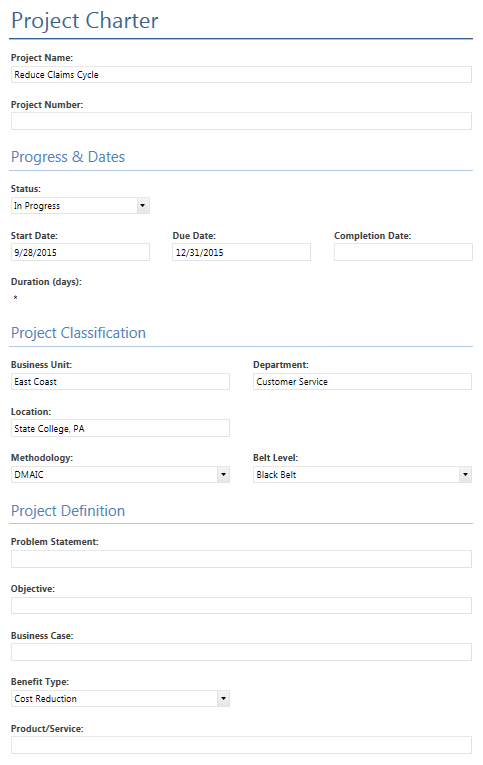by Alex Orlov, guest blogger
While it has been called the "million-dollar methodology" for the significant investment sometimes required to deliver results, Six Sigma has a wealth of practices that can be adapted to small and medium industries, home businesses and even personal finances.
 Organizations have used Six Sigma as a reliable part of the quality improvement process since 1986. And while a large Six Sigma project could cost anything from $1,000 to $1 million in work-hours and other resources, the results of such projects often far outweigh the investment. In addition to the direct benefits of the project, indirect benefits such as process optimization ensure that the benefits include improved efficiency for years to come.
Organizations have used Six Sigma as a reliable part of the quality improvement process since 1986. And while a large Six Sigma project could cost anything from $1,000 to $1 million in work-hours and other resources, the results of such projects often far outweigh the investment. In addition to the direct benefits of the project, indirect benefits such as process optimization ensure that the benefits include improved efficiency for years to come.
The question we come to is this: Does Six Sigma have anything to offer a layperson to improve their daily efficiency? As an instructor and practitioner, I see several important lessons from the Six Sigma methodology that can benefit anyone:
Tip 1: A Goal worth having is worth Documenting
Common sense dictates that the first step to achievement is to have goals. From the short span of a day to an entire lifetime, goals help focus our efforts. The first step to personal and business efficiency is to clearly state and document goals for future reference. Six Sigma calls this documentation of goals, plans and potential problems a "project charter."
|
|
| A project roadmap or charter template like this one in Minitab Engage process improvement software can help you plan and complete any project. |
If there is a first step to increased efficiency, stating and writing down clearly defined, well thought-out, specific goals is certainly one of the top contenders.
Tip 2: Planning: Don’t leave home without it
While this is one of the most preached and widely accepted clichés, planning receives more lip service than it does actual effort. In my corporate experience, I have found that few people actually invest time to plan their activities. The first element of efficiency that may be gleaned from Six Sigma is the practice of good planning. So what is a plan? In two words: actions and deadlines. Distilled down to its bare essence, a plan details what you are going to do towards achieving a goal and by when. Adhering to an action plan is the heart of Six Sigma.
Tip 3: Understand WHAT is wrong before asking WHY
One of the biggest problems with efficiency is that hours of effort may be directed at finding a solution without understanding the true nature of a problem. Six Sigma dedicates an entire phase of its methodology to identifying, understanding, and documenting the nature of the problem. As problem-solving individuals and businesses, you need to honestly and candidly identify what your problems are before you proceed to the discussion of why they exist. For example, one organization I worked with spent years trying to "fix" attrition without identifying that poor profitability and quality was the problem. They had been immunized to the profitless, de-motivating environment to the point that they did not realize that people quit simply because they did not want to work in such an environment.
On the road to efficiency, in life as in business, it is vital to recognize a problem exists before you can ask why.
Tip 4: Be specific – Ask “How Much?”
Over the last few years, I have had the opportunity to spend time with business owners who like a ‘take-it-as-it-comes’ approach to doing business. While they have an idea of what they want to do with the business, I have found most of their "goals" were very generic and gave no sense of progress. To quote a young director of a startup I happened to speak with, “My goal is to break even in a year’s time and be consistently profitable in the next three years.” To me, this represents an incomplete goal. As you have no doubt asked, “How profitable do you want to be?”
An important part of having goals is to be able to quantify them. Six Sigma teaches us that if we can’t measure it, we can’t control it. Efficiency is impossible if you don’t know how efficient you are.
Tip 5: Without people, a process will fail
If anything, good Six Sigma is an intensively collaborative effort. From defining a problem to identifying what is important to a customer, from brainstorming for potential solutions to the actual work of implementing solutions, people form the core of a good Six Sigma project. An important lesson here is to collaborate and associate with people who can offer ideas, give constructive criticism, and empower the attainment of your goals.
Six Sigma, like daily efficiency, relies on people working together to achieve a common measurable goal and the effective use of collective intelligence.
Tip 6: Whenever you can, seek out and use data to aid a decision
The human ability to approximate is a mixed blessing. While our powers of estimation are excellent, our precision is not as evolved. Another important lesson from Six Sigma is to ask for, seek out and use data to aid a decision. Six Sigma cannot make you or your business more efficient all by itself. It takes you to make a decision based on what your customers and your stakeholders are telling you.
More often than not, this qualitative information is made available in the form of numerical data. To simplify Six Sigma for the purpose of this discussion, the methodology is about manipulating data in order to give you a true picture of the road to your goals.
Whether it involves a personal budget or transforming a home business or even managing personal efficiency at work, gathering data and analyzing it helps you to know where you are before you begin to improve efficiency.
__________________________________________
About the Guest Blogger:
Alex Orlov learned Lean and Six Sigma from his work as a Quality Assurance Analyst for a BPO company in Eastern Europe, but he sees process optimization everywhere and wants to show that these methods can be applied in some form to all aspects of life. He runs WhatIsSixSigma.net, a site dedicated to simplifying Six Sigma and showing that its tools and methods can be applied with great effectiveness not only to the corporate environment but also to our personal lives.
Would you like to publish a guest post on the Minitab Blog? Contact publicrelations@minitab.com.




